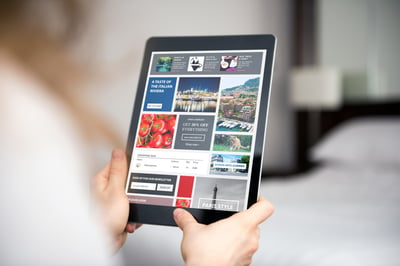October 31, 2022
 by Yurii Filipchuk / October 31, 2022
by Yurii Filipchuk / October 31, 2022

The non-fungible token (NFT) market is on the rise, with different projects serving as fuel despite the recent drop in the market.
NFTs sell for millions of dollars, captivating the attention of investors, aesthetes, techies, and gamers worldwide. Today, many newcomers are looking for the best way to either enter the NFT arena or own an NFT. Although the time is difficult for the NFT market, the revenue is expected to show an annual growth rate of 18.55% and is projected to reach $3.16 billion by 2027!
This will lead to more NFTs, bids, and returns. But there’s another thing preventing potential participants from capitalizing on the projections: the path to successfully launching an NFT. Launching your own NFT isn’t a walk in the park, especially when you aren’t up to speed on the industry.
In this article, you’ll get a brief overview of NFTs and how to successfully launch one for your business.
Source: ARTnews
Web3 is just around the corner and, in many ways, already influencing today’s world. NFTs are integral elements of this new web environment.
With Web1, people got access to the internet and could instantly consume information online. Content creators were limited, but content consumers were numerous.
The internet of yesteryear lacked the visuals, controls, forms, and interactivity we enjoy today. There was little interaction and very few ads. If you knew how to use a search engine, you could find what you were searching for. But that summed up everything users could do online.
As technology advanced, the internet had to adapt to accommodate the experiences users were looking for. This paved the way for the next and current phase of the internet, Web2.
Web2 is much more interactive and allows users to do more than just read and browse the internet. This internet phase is all about the user experience and user-generated content. It’s a better version of its predecessors and is fueled by Javascript.
With Web3, content creators wouldn’t only generate content but also own and monetize it. Essentially, the internet is moving away from centralized platforms like Google, Facebook, and Twitter toward decentralized, open, and anonymous platforms.
Tim Berners-Lee
Inventor of the World Wide Web
Web3 is about decentralization, openness, trust, and autonomy. It’s based on distributed ledger technology (DTL) that ensures the transparency and authenticity of the information shared on the web.
While Web3 isn’t fully here yet, different elements are working their way into our current internet, including NFTs, Blockchain, Metaverse, and Decentralized Finance. Although there’s a lot of work and tech issues to resolve, the process is well underway.
NFTs and metaverses are two areas with limitless potential for businesses. They enable a more real-life form of content participation. Many companies are still uncovering the opportunities these technologies offer and what they mean in the long term. With the right information and guidance, you can easily launch your own NFTs and build a more loyal community.
In the future, you might be able to store NFTs in wallets and use them as keys to sensitive biometric or banking data. You can even use them as your virtual identities. In the metaverse, you can use NFTs to access particular communities, just as we use “Sign in with Apple” or “Sign in with Google”. Intriguing, right?
With all the work currently being done on NFTs, let’s see how you can launch one for your business.
Source: World Economic Forum
Here are five crucial tips to make your NFT launch a success.
1. Study your target audience and design art that they will like
One of the biggest mistakes when launching an NFT is promoting it to everyone, everywhere possible. This often leads to an enormous waste of time and resources since it’s impossible to target multiple audiences for a single product at once. If you don’t know your target customers, how can you create an NFT that will appeal to their buying preferences?
Sending out ads for dog clothes to a young adult who doesn’t have any dogs is a waste of resources. You also probably wouldn’t send it to cat owners. Both segments will find your message irrelevant. So it’s better to identify your target audience, segment it, and fine-tune your marketing campaign.
Note that your target audience may consist of different segments (groups of people) sharing the same characteristics.
Take Starbucks, for example. Some segments of Starbucks' target audience may include businesspeople who need a convenient way to grab a coffee on their way to work, busy individuals who need a place to join a meeting, or students who want a place to hang out after classes. So, you can target different audience segments, but you need to adjust your marketing campaigns to deliver the right message.
Once you understand your target audience, you can start generating your NFT art that appeals to your target market. If you miss out on customer research, you can’t design the right imagery that customers will want to invest in.
Another great example is Everdays: The First 5,000 Days. It’s a mix of fantastical, abstract, absurd, and deeply personal pictures that turned out to be one of the most expensive sets of NFT artworks, selling for $69.3 million.
But the following NFT wasn't launched as a commercial product. Even while launching a commercial NFT project, it's better to have a compelling story behind it.
Bored Ape Yacht Club (BAYC) is more than just 10,000 images from various apps. It was launched with a vision and narrative. It tells the story of apes living in a future of wealthy crypto magnates who enjoy meeting like-minded apes at a yacht club.
The project has a detailed roadmap where potential users can discover all the benefits of being early buyers. With a perfectly designed website and a fun brand voice, BAYC creates the sense of an exclusive community you can only access by buying their NFTs.
Choosing a blockchain platform and a marketplace is vital for your project's success. A marketplace is a platform where you can sell NFTs, and a blockchain is a tool for minting them. Ethereum is one of the most widespread blockchains used for minting NFTs, and OpenSea is a popular platform for selling NFTs.
But these are not the only options. There are alternatives like building your own blockchain or launching your own NFT marketplace. Each option has its undeniable benefits. For example, creating your own marketplace gives you full control over the launch of NFTs and increases your revenue.
Source: SoFi
Selecting both a marketplace and blockchain go hand in hand. While some marketplaces only work with Ethereum-based NFTs, others promote their own blockchains, sidechains, or currencies.
Before setting up the NFT minting process, find out the pros and cons of the available options to choose the most suitable solution for your business. Some have lower fees, and others offer unmatched interoperability. After you’ve made up your mind about your blockchain, it’s time to choose where to sell NFTs.
Source: Party Space
The metaverse offers limitless opportunities for NFTs. Imagine your avatar walking into a digital Prada store and talking to a Prada consultant’s avatar to get some advice. You buy a new Prada bag and add it to your own collection of NFTs. Welcome to the metaverse, the intersection of the real world and virtual reality.
Brands don’t only benefit from launching branded NFTs in a metaverse. Since NFTs are digital property, you can allow users to acquire co-ownership. It’s like a share in a company where investors get their piece of the pie (in your case, of a unique NFT), making it more profitable and raising the price of all other shares.
Source: Forbes
As an NFT creator, you can organize a gallery of your most prominent NFT artworks. Users can visit it, view your works, and even invest in them. The metaverse gallery can meet demand and create additional sales opportunities through the hype around virtual NFTs.
Doge Temple is one such metaverse gallery where Doge meme lovers can socialize and discuss their favorite NFT Doge meme. The Doge Temple can also be used as a place for virtual parties or metaverse events.
When creating a community in the metaverse isn't enough for the success of your NFT, you can create a metaverse NFT marketplace fully integrated into a virtual world. They’re quite similar to traditional marketplaces but tied to a virtual world.
Here you can showcase your NFTs and sell them in exchange for crypto tokens. Connecting these marketplaces with the metaverse allows users to experience a sense of touch and sight while providing lifelike experiences.
Setting up an NFT-based community in the metaverse can generate additional hype around your NFTs since only users that own the NFTs will have access to such communities. All in all, the metaverse and NFTs complement each other by generating better growth opportunities for NFT creators.
4. Build an engaged community
The NFT economy is community and creator-driven, so creating an engaged community is important to your NFT’s success. The best way to build a community is to tell your story and lead with what you’re passionate about.
The more hype and excitement surrounding your NFT, the more people it can attract. Suppose you’re ready to launch your NFTs. In that case, it’s better to start building a solid community around the launch beforehand.
The best product launch for NFTs is a fast sell-out. These fast-selling NFTs make the first headlines and capture the attention of NFT investors. Without a loyal audience, quickly selling out isn’t possible. That’s why building an engaged community is worth its weight. Deliver fresh content and product teases to get your fans excited and ready for your big day!
The popularity of NFTs is booming and shows no sign of waning. Hundreds, if not thousands, of NFTs enter the market every day. As an NFT entrepreneur, you have to keep track of what’s currently trending and on the horizon.
Some upcoming NFT projects may also have something in common with your project, and the key to producing a highly-valued NFT is its uniqueness. Luckily, there is no shortage of apps and websites where you can check upcoming NFT launches.
With an NFT Calendar, you will be the first to know about every NFT drop. It features all NFT releases from well-known to new-entry artists. Don’t forget about industry-specific events where you can get the latest insights, connect, and share your ideas with industry leaders. Moreover, being a speaker at such conferences can help you reach more NFT enthusiasts and make a splash.
NFTs are versatile in the business sector. They aren’t just digital art objects but powerful business tools. NFTs can represent a host of digital and physical assets like tickets to events, real estate, intellectual property, and more.
NFTs open new doors for brands to offer a unique experience, raise capital, and target new customers. They’re suitable for all industries.
You can turn anything into an NFT and expand your brand across both the physical and digital worlds. McDonald’s, Nike, Gap, and Coca-Cola have already offered NFT products to their consumers. Being among the first adopters has considerable benefits.
Source: finfan
To be fair, most brands and businesses are hesitant to adopt NFTs simply because they don’t know enough about them. Remember, the brands and businesses that entered the internet, e-commerce, and social media spaces first dominate these platforms. A few years later, NFTs will likely become a central digital touchpoint between brands and customers.
While businesses are slow to adopt NFTs, the gaming world has already welcomed a new breed of games – play-to-earn NFT games. Now players can monetize their hobby and take full ownership of in-game assets in the form of NFTs. Skins, in-game currency, weapons, characters, and virtual land on the metaverse can be traded, sold, or exchanged like any other NFT.
For example, players can purchase plots of land and turn them into anything they want, like digital art galleries or concert venues in Decentraland. Then, these plots are represented as an NFT, which can be sold in the open marketplace.
The Sandbox is more than just a p2e game. It’s a play-to-earn virtual metaverse where your avatar and you can own land, play games, meet friends, and build your game or experiences. Everything is fixed in the form of an NFT that can be traded in the Sandbox Shop.
Besides the names mentioned above, dozens of other p2e NFT games are on the market. So the main question is – will NFTs completely overtake the gaming industry? Who knows. But still, anyone who is currently in this sphere has an early mover advantage and can take the best market share.
NFTs are luring more creators and companies to launch their own NFTs. The market is booming with crazy collectibles valued at billions of dollars and priceless art objects. You can only stand out from the NFT crowd if you know how to set up a proper launch.
Digital content does have value, not only for NFT enthusiasts but also for brands and businesses, especially with the rise of Web3 and metaverses, where NFTs play a central role. With the metaverse and NFTs, companies and creators can discover new opportunities, build better audiences, connect with their customers, and expand their businesses.
The metaverse is here to stay and change how you view software development. Find out what the metaverse means for future software development and why tech companies should gear up for the coming revolution.
Yurii is the CEO and founder of the Ukrainian metaverse for remote teams and online communities: Party.Space.
Since Mark Zuckerberg first mentioned it, everyone has kept talking about the metaverse as a...
 by Yuri Milyutin
by Yuri Milyutin
In the world of rapid product development and digital advertising, getting a glimpse of market...
 by Christiana Marouchos
by Christiana Marouchos
Remarketing is the reason you end up seeing so many relevant ads on random pages after paying...
 by Ricky Wang
by Ricky Wang
Since Mark Zuckerberg first mentioned it, everyone has kept talking about the metaverse as a...
 by Yuri Milyutin
by Yuri Milyutin
In the world of rapid product development and digital advertising, getting a glimpse of market...
 by Christiana Marouchos
by Christiana Marouchos


